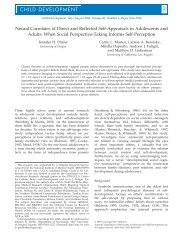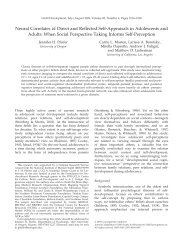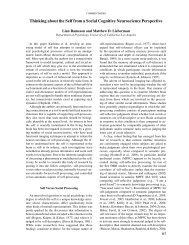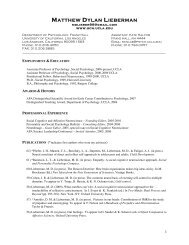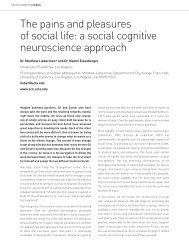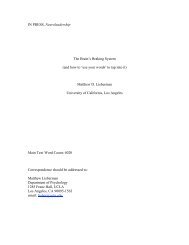In Progress – DO NOT CITE Attributional inference across cultures ...
In Progress – DO NOT CITE Attributional inference across cultures ...
In Progress – DO NOT CITE Attributional inference across cultures ...
Create successful ePaper yourself
Turn your PDF publications into a flip-book with our unique Google optimized e-Paper software.
Culture, Attribution, & Automaticity<br />
14<br />
sensitive to or less willing to incorporate dispositional contextual information into their<br />
situational <strong>inference</strong>s. According to this explanation, greater emphasis on the situation<br />
may diminish attention given to relevant dispositional information even when EA<br />
participants are not under load. Alternatively, as we have hypothesized, it may be the<br />
case that EA culture promotes a situationalist theory of behavior, and to the extent that<br />
EA individuals have their cognitive resources free, they will correct their automatic<br />
<strong>inference</strong>s accordingly.<br />
<strong>In</strong> study 3, we employed a D-sequence augmenting procedure that pits these two<br />
accounts against one another. This procedure is similar to study 1 except that the content<br />
of the situational information provided indicates that the situation is quite unlikely to<br />
have caused the observed behavior. If EA participants differed from US participants in<br />
study 2 because the constraint information was dispositional, then the cultural differences<br />
should disappear in a D-sequence augmenting procedure in which the constraint<br />
information is situational. If, however, EA participants use their available cognitive<br />
resources to apply a situationalist theory of behavior, then US and EA attributions should<br />
look different in a D-sequence augmenting procedure when participants are not under<br />
cognitive load. This would occur because the situational constraint information itself<br />
should normatively produce stronger dispositional attributions as the constraint<br />
information suggests that the situation was unlikely to have caused the observed anxious<br />
behavior. Thus, greater attention to the specific content of the situational constraint<br />
information should produce stronger dispositional attributions. To our knowledge this is<br />
the first study to disentangle attention to situational information from the implication of<br />
the specific content of that information in a cross-cultural attribution paradigm.



